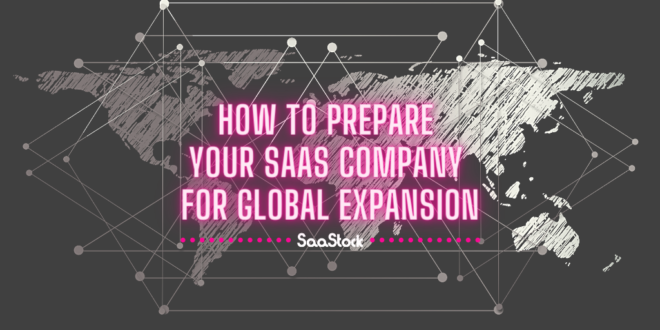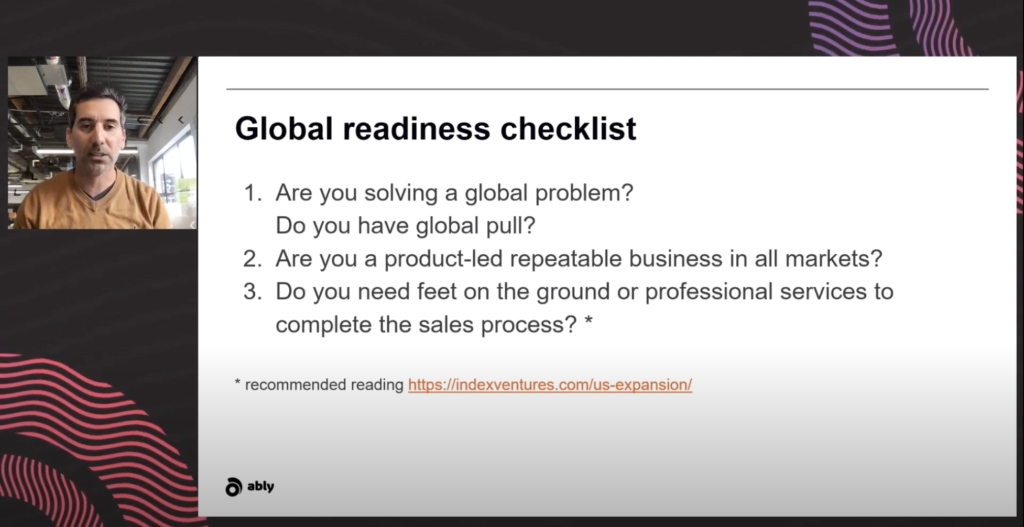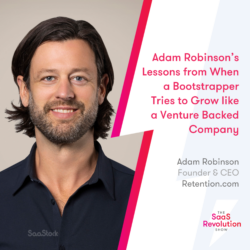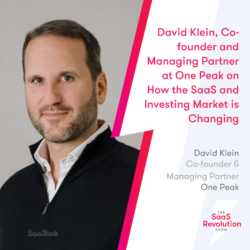As SaaS companies grow, it becomes increasingly important to identify expansion opportunities and develop strategies and scalable processes to support them. Some companies move upmarket and start selling to the enterprise where they’d previously sold to SMBs. Some take the opposite approach and move downmarket. Others move into new verticals.
And then there’s international expansion. According to Paddle’s CEO Christian Owens, expanding internationally can boost revenue growth by 13%.
But with many cultural, financial and practical differences to consider, there’s no one correct way to expand internationally. Should you master local and regional markets first, then grow internationally, or go global from day one?
This blog post looks at the most important aspects to consider when planning to expand to foreign markets, pulling in expert advice from SaaS leaders around the world.
Is your SaaS ready to expand internationally?
The first question to consider is: is your SaaS company ready to expand internationally?
Today, SaaS businesses are built on modern cloud platforms that can be accessed by, and scale to users, all over the world. So it can be tempting to assume that you should be a global business, right from day one.
But while it may be easier than ever before to build a global audience, that doesn’t necessarily mean your business or your product is ready to go global.
According to Stephen Carpenter writing for TechCrunch in 2015:
“When 25 percent or more of your business is coming from international markets, it’s time to scale outside your home country.”
This is a useful benchmark to keep in mind. More recently, at SaaStock EMEA earlier this year, Matthew O’Riordan (CEO & Co-Founder at Ably) shared a global readiness checklist to help you understand if your SaaS is ready to expand internationally. He recommended asking your business these three questions:
- Are you solving a global problem? Is there a global pull for your solution?
- Are you a product-led repeatable business in all markets?
- Do you need feet on the ground or professional services to complete the sales process?
Watch his keynote with Jonno Southam (Senior VC Business Development at AWS) here.
Of course, there will be other things to consider depending on what region you’re looking to expand into, and where you already have an established presence (your home region). But these three questions are a great starting point to help you understand if your business is ready to expand internationally, or if you still need to lay the foundations in your home region first.
What are the biggest challenges facing SaaS founders expanding internationally?
Internationalisation is a real growth opportunity for SaaS companies, but it comes at a cost.
At SaaStock EMEA, Paddle CEO Christian Owens delivered a keynote on setting yourself up for sustainable growth in new markets. He shared some of the biggest challenges that SaaS founders face when branching out into new markets:
- Regional cultural differences
- Language differences
- Currency differences
- Accepting international and cross-border payments
- Tax liabilities and regional regulations.
Watch his keynote from SaaStock EMEA here.
To successfully scale your SaaS company internationally, it’s a balancing act of operational logistics (such as accepting payments) and cultural alignment.
Even if you’re expanding into a region that on the surface seems like it’ll be quite similar to your home region (for example from Western Europe into the US, or from the US into Europe), it’s important not to underestimate the less clear-cut cultural differences.
If you’re expanding into a region that’s less similar to your own (for example, from Asia into North America, or from North America into Latin America) then it’s even more important to take the time to understand these differences, so you can build empathy with new team members, customers and users in the region.
Different approaches to expanding internationally
There are several different routes to market in new regions:
- Direct: setting up a new regional HQ. For example, Salesforce was founded in 1999, and in April 2001 it announced its expansion into the worldwide marketplace with new regional headquarters in Dublin and Tokyo.
- Acquisition: acquire a business in the region to become your ‘feet on the ground’. Workday is a good example here: it acquired Cape Clear in 2008 to create its EMEA HQ.
- Reseller partnership: joining with a trusted partner to bring your SaaS to market in the new region. In certain regions (like the Nordics, Latin America and Japan), companies really prefer to have a relationship with local software companies rather than international ones.
- Remotely: keep your team in your home region but expand sales and marketing activity to target new regions. There are many ways to roll this out, but one approach is to hire for different specialisms in different regions. For example, having your customer success team in the USA, or your engineering team in Europe. Having specific business functions in specific geographies helps overcome the challenges associated with localizing salaries, and avoid pay disparity between team members.
Whatever route to market you choose, when it comes to expanding internationally, there are two main approaches that we see companies take:
- If you’re in a fairly disparate region where markets vary greatly between countries (for example: Asia or Latin America), then companies expand within their own region as the first stage of internationalisation.
- Alternatively, if your home region is quite cohesive, with less variation within the region (for example: North America), then companies will look further afield and make the leap into new global regions when expanding internationally.
Advantages of expanding in-region first
There are several practical advantages to expanding within your home region first, before jumping into new global regions:
- Time zones – broadly speaking, there’s likely to be less variance in time zones within a region than if you jumped straight to expanding worldwide. If this is your first step in expanding internationally, doing so closer to home may be easier to manage from a logistical, day-to-day working standpoint than making a bigger leap overseas.
- Cultural alignment – if you’re in a more cohesive region, geographical proximity may help you build cultural alignment within the new market and with your new international team.
- Local laws and regulations – you may already have a good understanding of the local laws and regulations that will affect the day-to-day running of your business, compared with if you were expanding into a completely new region.
- Price sensitivity – Paddle’s SaaS Commerce Trends: 2020 Report revealed that 27% of companies found that determining the right pricing or plans to be the most difficult aspect of expanding internationally. You may find there is less variance in price sensitivity between countries in the same region than from one region to another.
Company spotlight: Rock Content
Rock Content CEO Diego Gomes talked at length at SaaStock LatAm 2020 about his experience of growing Rock Content globally. Founded in Brazil in 2013, it now has offices in Mexico, USA and Canada.
“We started local: we wanted to win Brazil. Phase 1 was all about building a brand and winning our domestic market. Phase 2 was to become a regional leader. It started with some of our customers in Brazil asking for content in Spanish. We also had a small volume of leads coming in from Mexico and Colombia. We then started experimenting with Spanish-language demand generation. This led us to hiring our first Mexican sales rep, and then our CRO moved to Mexico to open our office there – our first office outside of Brazil.”
Watch his keynote from SaaStock LatAm here.
Today, Rock Content has expanded further, with additional offices in the USA and Canada. But the first step on its international journey was to expand in-region, to build its business within Latin America first, before expanding out into North America.
Advantages of expanding globally from the start
If expanding in-region offers practical advantages, going global and expanding into new regions offers its own advantages:
- Immediate access to new markets – expanding into a new global region increases your Serviceable Addressable Market (the portion of your total addressable market that you can actually reach with your product or service).
- Opportunity to provide global support and service – if expanding in-region helps you work without too much disruption due to time zones, expanding internationally gives you an advantage to provide customer support coverage, more hours of the day.
- Brand and reputation-building – according to Paddle’s SaaS Commerce Trends, SaaS companies who’ve expanded internationally are perceived as more mature companies. Expanding internationally is a big investment, as well as a big opportunity, so within your home region the news that you’ve opened new offices internationally can offer your reputation a boost.
Company spotlight
HubSpot is a great example of this global-first expansion path. Today they have 3700 employees across 11 global offices. They started from Cambridge, Massachusetts, opening their first office there in 2006. Then in 2013 they announced the opening of their EMEA HQ in Dublin, Ireland. This was followed by the opening of their APAC HQ in Sydney, Australia in 2014. Taken from the press release announcing their new EMEA HQ, HubSpot had:
“[M]ore than 710 of their 8,600 customers are outside the United States and Canada, representing 56 countries.”
Today, HubSpot has three offices in the USA, four in EMEA, one in Latin America, and three in APAC – a truly global business.
Does localization matter?
When expanding internationally, it’s important to consider localisation in three key areas:
1) Language
Expanding into new regions means you need to think about translating your content, product and communications.
“As you begin to expand into countries with moderate to very low English (or whatever your native business language is) proficiency, you will need to invest in resources that will allow you to communicate with your customers in their native tongue. This includes hiring support staff who can speak the language and making sure that support documentation, marketing materials, dunning emails, invoices and other customer communications are available in that new language, too.”
2) Marketing and sales
You may need to localize your marketing activities too. As well as translating your website and marketing materials, you’ll also need to think about translating your lead generation activities: paid advertising, social media, blog posts, etc.
Additionally, new regions may require branching out into new channels. For example, new social media channels, or regional trade shows and events.
You may even need to localize your whole sales process – not just in terms of having feet on the ground in the region, but by aligning your sales approach to the culture and attitudes of the region. For example: what seems like a normal sales pitch in the USA may come across brash and overbearing in Europe, and a European-style sales call may seem unconfident and uninspiring across the pond.
3) Pricing
Moving into new international markets also means localizing your pricing. It may be tempting to just look at that at a superficial level: changing from dollars into Euros, for example. But true pricing localization means understanding the markets you’re selling to and using this information to shape your pricing.
“Look at how customers in that geography view the software you’re selling and how much they’re willing to pay for it. Once you’ve tapped into the country’s buying culture, make sure the price is pitched correctly and that it’s competitive in the region’s market.” – Paddle
Check out this post from Rippling for more on localisation considerations for SaaS companies.
Closing thoughts
There’s a lot to consider when expanding internationally. Although global traction can happen organically from a very early stage in your company’s life, startups must be strategic about scaling into international markets.
At SaaStock LatAm Diego Gomes shared his experience of building a global company starting from Brazil:
“In the beginning I thought: it all starts with thinking global. I aspired to build a global company. But pretty soon you learn that it’s not that easy. First you have to master a global language, and you have to have your whole organisation operating in a single shared language. And a global mindset: everything you do has to take into consideration that the world is your new market. It’s the opposite [of what I first thought]: you start with the global mindset, then you evolve with a global language, and then you become a global company – not the other way around.”
It’s important to remember that your experience of scaling internationally will vary depending on where you’re starting from. Scaling out of the USA is not the same as scaling out of Iceland. The former has a huge market in its own backyard. The latter has no choice but to think globally from day one.
Your SaaS company has its own unique path to growth, but several successful ways to globalise have been tried, tested, and proven by startups and scaleups from all over the planet. Take time to understand the path that is likely to work for you and your business, and use that as your blueprint. From an informed position you can hire or partner with the people and businesses you need to expand across borders. With them you can create the strategies and execution plans to become the next big global story in the SaaS scaleup world!








